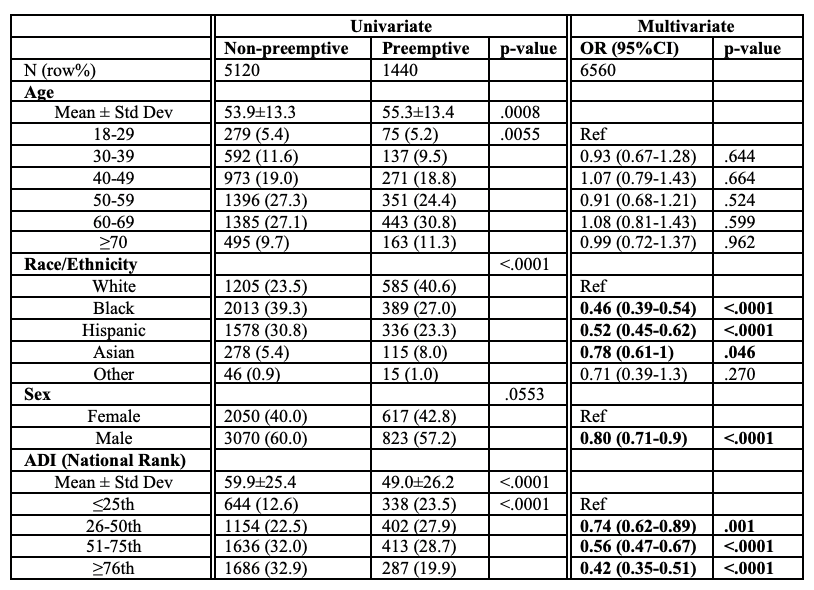Non-White and Low-Socioeconomic Status Patients Are Less Likely to Present for Preemptive Kidney Transplant Evaluation: An Assessment of Referrals at a Single Center Serving a Diverse Urban Population
Houston Methodist, Houston, TX
Meeting: 2022 American Transplant Congress
Abstract number: 1738
Keywords: Kidney, Kidney transplantation
Topic: Clinical Science » Kidney » 50 - Health Equity and Access
Session Information
Session Time: 7:00pm-8:00pm
 Presentation Time: 7:00pm-8:00pm
Presentation Time: 7:00pm-8:00pm
Location: Hynes Halls C & D
*Purpose: While preemptive kidney transplantation is the optimal renal replacement therapy for patients with end-stage kidney disease (ESKD), low rates of preemptive transplant, particularly for racial and ethnic minorities persist. To determine areas of opportunity for increasing preemptive transplant referrals, we examined differences in clinical characteristics between preemptively referred patients compared to patients referred after dialysis initiation.
*Methods: All patients referred to the transplant center between 6/1/2016 to 5/31/2021 for kidney evaluation were included, excluding patients missing requisite data. Multivariate logistic regression was used to evaluate demographic factors (age, race/ethnicity, and sex) and socioeconomic status (SES) predictive of preemptive referral. The Area Deprivation Index (ADI) provides a proxy measure of SES by using census cell block to quantify a score for intra- and interstate comparison. The ADI score is a ranking between 1-100; a score of one equates to the lowest level of disadvantage. Preemptive status is binary, based on self-reported data recorded during the referral telephone encounter.
*Results: A total of 6560 patients were referred in the study period (22% preemptive). Black, Hispanic, and Asian patients all showed a statistically significant reduced likelihood of preemptive referral (ORs=0.46 (0.39-0.54), 0.52 (0.45-0.62), and 0.78 (0.61-1), respectively). ADI, categorized by quartile, shows an increasingly reduced likelihood of preemptive referral as the deprivation rank increases (ORs=0.74 (0.62-0.89), 0.56 (0.47-0.67), 0.42 (0.35-0.51)), respectively. Sex was statistically significant, with men less likely than women to present preemptively at referral (OR=0.80 (0.71-0.9)).
*Conclusions: There are missed opportunities to increase preemptive referral rates for non-White patients, low SES patients, and male kidney patients. The ADI is a useful metric for both research and practice efforts focused on addressing social determinants of health for the ESKD patient population. Based on these results, efforts should be made to increase outreach to underserved groups.
To cite this abstract in AMA style:
Menser T, Hobeika MJ, Hsu E, Moore LW, Waterman AD, Gaber AO, Knight RJ. Non-White and Low-Socioeconomic Status Patients Are Less Likely to Present for Preemptive Kidney Transplant Evaluation: An Assessment of Referrals at a Single Center Serving a Diverse Urban Population [abstract]. Am J Transplant. 2022; 22 (suppl 3). https://atcmeetingabstracts.com/abstract/non-white-and-low-socioeconomic-status-patients-are-less-likely-to-present-for-preemptive-kidney-transplant-evaluation-an-assessment-of-referrals-at-a-single-center-serving-a-diverse-urban-population/. Accessed December 17, 2025.« Back to 2022 American Transplant Congress

